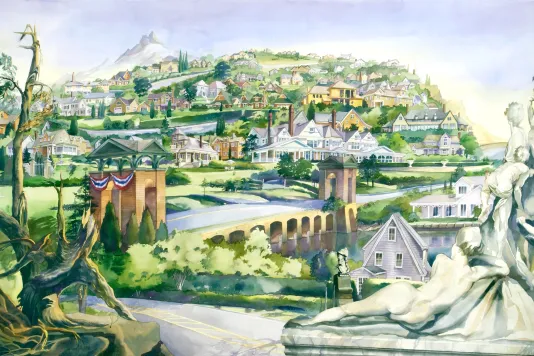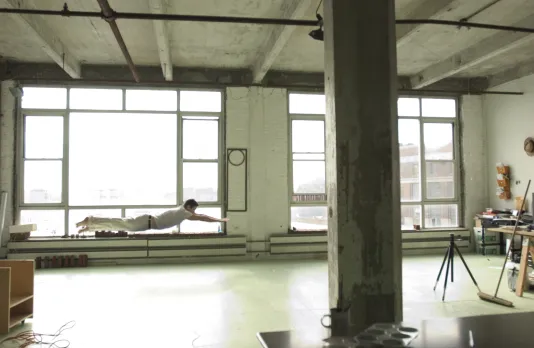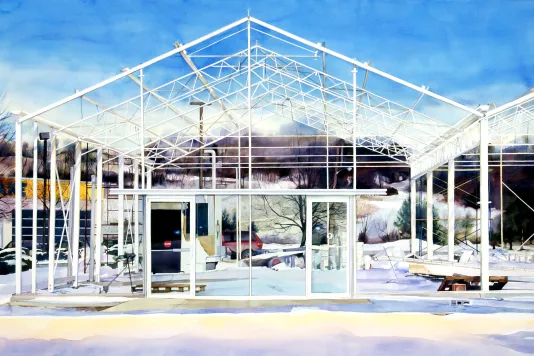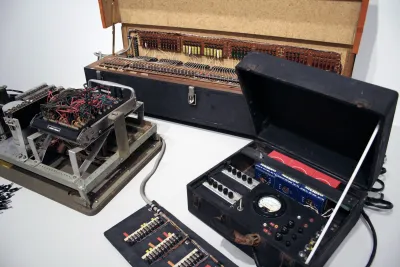Chris Doyle, Extraordinary Perceptual Dilemmas and the Madness of Climbing, Video still, (2003), 1 minute, 30 seconds
Chris Doyle: Recent Video Works
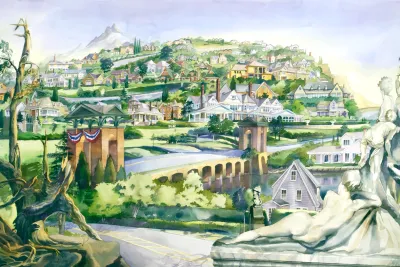
Chris Doyle’s themes are drawn from the psychology of everyday life. By using only the most low-tech special effects, he transforms everyday images into short films that are magical and moving.
Doyle is perhaps best known for Leap, a public artwork sponsored by Creative Time in April, 2000, for New York City’s 2 Columbus Circle. A celebration of hope, Leap, showed moving images projected onto a tall building of various New Yorkers from all five boroughs jumping skyward. Beginning at dusk, depictions of a continuous stream of New Yorkers appeared at the base of the building, and one by one, four hundred and twenty jumpers soared up the height of the facade, slipping into the night sky.
In recent years, Doyle has worked less in the public sphere, and more in the private fictional spaces he creates in his videos. This selection of videos shows a wide range of Doyle’s interests, but each manifests a dreamlike vision in which the quotidian becomes extraordinary. Doyle likens his practice to a “Pathetic Magician, a sad sack trying to make magic out of what is at hand.”* Writing in Art Newsmagazine Linda Yablonsky said “(Doyle) has cast hot dogs, red bricks, and lawn chairs as human surrogates in videos that constantly mix storytelling with abstraction.” **
Flight (2005) shows the artist doing aerial circuits in a Superman pose around his Brooklyn studio before heading out the window. Today, when even amateurs have access to Hollywood-quality special effects, the artist’s goal is clearly not a seamless effect. The jerky motion is left as a clue to his methodology, in which the artist performed 230 individual leaps and then sequenced the still photographs to depict flight.
Tower (2005) uses an animation technique known as “claymation”. Doyle has turned the descriptive form upside down; and we see the effects of unseen artist’s hands on the tower, wounding and suturing the form and twisting it like taffy.
Hotel Bernini I (2004) is among Doyle’s most evocative works, in that how one perceives the turbulence of the white hotel sheets will invariably be affected by one’s own psychology. Whether it is understood as the result of anxiety, insomnia, or passion, the sheets are now vacant, and the bodies that gave them life are now missing.
Watershed (2004) shows a partly deconstructed bank building that the artist found in upstate New York. Using only flashlights for special effects, Doyle uses the skeletal frame as a metaphor for the psychological structures that contain thought, with the flashes of light serving as the events or perceptions that define human relationships. The artist appears at the very end sweeping up after the emotional fireworks.
Extraordinary Perceptual Dilemmas and the Madness of Climbing (2003) was a site specific project done for an exhibition in East Hampton, Long Island, NY. Like many natural paradises that have become popular resorts, longtime residents describe the area’s past in idyllic terms that are too dreamy to be true. The old movie feel and the slightly horrific over-profusion of images are meant to conjure the dark side of paradise.
